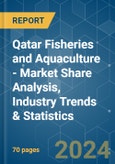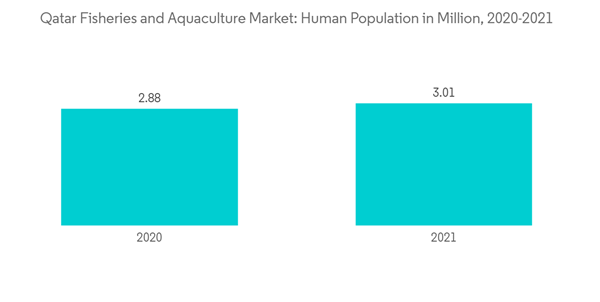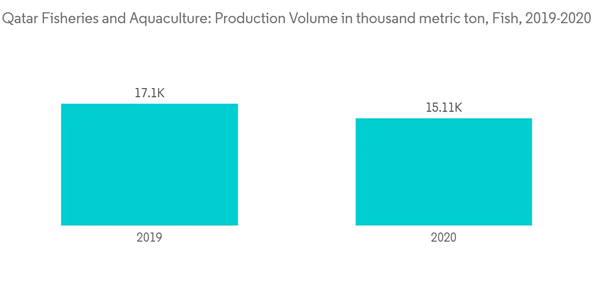The Qatar Fisheries and Aquaculture Market size is estimated at USD 171.58 million in 2024, and is expected to reach USD 218.99 million by 2029, growing at a CAGR of 5% during the forecast period (2024-2029).
Along with this, the country's consumer food choices have changed due to growing urbanization and an increase in the percentage of wealthy people. Unlike the less diverse diets of rural cultures, city inhabitants prefer a diet high in animal proteins and healthy fats. As a result, the food consumption pattern is gradually shifting away from carbohydrate-based staple foods to protein-rich meals, including fish, meat, and dairy. The population growth and consumption rates are likely to be the major factors driving the fisheries and aquaculture sector in the country.
Moreover, the growing concerns about obesity and diabetes in the country and the presence of various expatriates have also resulted in rising demand for healthy foods. As fish and other aquatic species provide health benefits, the opportunities for healthy and light value-added seafood products are anticipated to increase. Therefore, the demand for seafood products is expected to rise significantly due to the rising population and awareness regarding healthy foods, which is also anticipated to impact the market growth in the country positively.
Along with this, the farming operations launched by the ministry are pushing fish production on a large scale. For instance, in 2021, In a large-scale fish-growing operation, Qatar's environment ministry launched an effort with the goal of producing more than 600 tonnes of tilapia fish annually. As a result of these initiatives, developed by the government fish production is increasing in Qatar. For instance, according to World Bank data, the production of fisheries reached 15,109 metric tons in 2020 an increase from 14,200 metric ton in 2018.
This product will be delivered within 2 business days.
Key Highlights
- Over the long term, the fisheries and aquaculture market in Qatar is expected to grow steadily as people shift toward foods that are rich in protein sources. Additionally, after the effect of the pandemic, people became more health conscious. As fish and other aquaculture species are rich in protein, omega-rich fatty acids, iodine, and many health benefits, the demand is increasing on a large scale in the country. This has led to increased fish consumption, which is highly nutritious and has impressive health benefits.
- Along with this, the Qatari government is pushing some initiatives to diversify its economy. It is actively promoting investors and foreign companies to establish an enhanced sector for fisheries and aquaculture in the country. This has opened new opportunities for investors to finance RAS-based systems on farms, cage fish farming, etc.
- Furthermore, the increased research and development activities are also paving the way for the increase in the aquaculture industry in the country. For instance, in 2020, the Prime Minister and Interior Minister opened the Aquatic Research Centre in Ras Matbakh, Qatar. This center runs with a production capacity of two million fish larvae in one year. It will increase its targets to over 20 million fish larvae within three years and thereby helps develop Qatar's fisheries wealth.
Qatar Aquaculture and Fisheries Market Trends
Increase in Seafood Demand due to Rising Population
Qatar's rising population, booming economy, and popularity as a tourist destination have raised the demand for high-quality culinary products. For instance, according to the World Bank, the population in the country was 2.78 million in 2018. This rose to 3.01 million by 2021, placing a critical need on the sustainable and efficient management of marine resources and fish stock. Additionally, as affluent individuals control the majority of the country's private wealth, it is expected to experience the most significant increase in demand.Along with this, the country's consumer food choices have changed due to growing urbanization and an increase in the percentage of wealthy people. Unlike the less diverse diets of rural cultures, city inhabitants prefer a diet high in animal proteins and healthy fats. As a result, the food consumption pattern is gradually shifting away from carbohydrate-based staple foods to protein-rich meals, including fish, meat, and dairy. The population growth and consumption rates are likely to be the major factors driving the fisheries and aquaculture sector in the country.
Moreover, the growing concerns about obesity and diabetes in the country and the presence of various expatriates have also resulted in rising demand for healthy foods. As fish and other aquatic species provide health benefits, the opportunities for healthy and light value-added seafood products are anticipated to increase. Therefore, the demand for seafood products is expected to rise significantly due to the rising population and awareness regarding healthy foods, which is also anticipated to impact the market growth in the country positively.
Government initiatives are increasing the fish production
Qatar's fisheries sector is considered critical to promoting food self-sufficiency and increasing exports. As a result, Qatar has devised a strategy to stimulate investment in the country's fish farming. According to the aquaculture group's recommendations, coastal locations for the construction of farms were chosen. Additionally, the major companies are assisting Qatar's efforts to improve its food security by lowering its dependency on imports, achieving self-sufficiency in its fish consumption, and protecting the species. For instance, AQH a major business company involved in the aquaculture business in 2020 started Samakna a 50 km fish farming project in floating cages offshore in the northern part of the country which provides more than 3,000 metric tons of high-quality fish. This type of initiative is assisting the increasing fish production in the region.Along with this, the farming operations launched by the ministry are pushing fish production on a large scale. For instance, in 2021, In a large-scale fish-growing operation, Qatar's environment ministry launched an effort with the goal of producing more than 600 tonnes of tilapia fish annually. As a result of these initiatives, developed by the government fish production is increasing in Qatar. For instance, according to World Bank data, the production of fisheries reached 15,109 metric tons in 2020 an increase from 14,200 metric ton in 2018.
Additional Benefits:
- The market estimate (ME) sheet in Excel format
- 3 months of analyst support
This product will be delivered within 2 business days.
Table of Contents
1 INTRODUCTION
4 MARKET DYNAMICS
5 MARKET SEGMENTATION
Methodology

LOADING...










